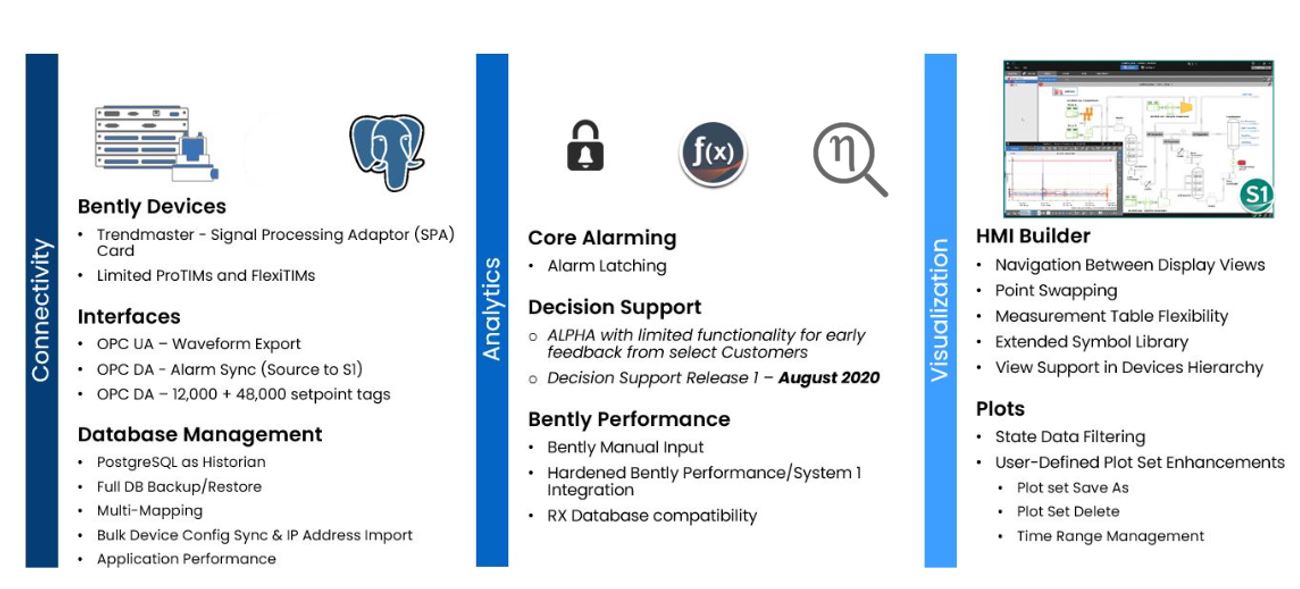
System 1 Use Case: Diagnostic HMI
Introduction
Process-intensive Industrial Operators are increasingly wading into the digital transformation revolution to streamline production in the face of globalization, a shifting workforce, and heightened cyber security threats. Delivering safe, reliable, and environmentally friendly operations while maintaining a competitive advantage over peers is virtually unachievable without intelligent adoption of technology and cultural acceptance of changes to long standing processes.
Bently Nevada has been partnering with customers to help solve these challenges. Through user research in 20 countries with more than 400 end users, we have studied our customers’ team dynamics, site processes, and technology suites to determine how System 1 can best support plant-wide machinery management. The resulting platform meets 11 unique customer use cases, with each use case leveraging a subset of System 1’s connectivity, analytics, and visualizationcapabilities. This Orbit article explores the diagnostic HMI use case and the application of System 1 for real-time and reactive machine monitoring.
Challenge
- In process-intensive industries, the control and protection systems are the foundation of critical machinery management. These systems, with the support of the operations team, help to mitigate environmental, safety, and productivity consequences by facilitating real-time control and shutdown.
- The rich data set collected by Edge monitoring systems and utilized for critical machinery management can be further leveraged to monitor machine and sensor health in real-time, while also forming the foundation of reactiveinvestigations when machine upsets occur. With access to this wealth of data, machinery engineers have the potential to achieve comprehensive machinery management across their plant. If so, then what is inhibiting the realization of this potential?
- For process-intensive industries, a primary obstacle to comprehensive machinery management is the scattering of data and capabilities across multiple technology platforms. This forces machinery engineers to move between the control system HMI, industrial historian HMI, and vibration monitoring system to get a complete picture of machinery health, with each posing limitations for comprehensive machinery management.
The scattering of data across disparate databases also amplifies the already enormous challenge of the Industrial IoT – how does an industrial operator achieve a comprehensive data lake for machine learning and analytics when that data is spread across different databases with distinct machinery contexts?
System 1 solution
In developing the next generation System 1 platform (a.k.a., System 1 evolution), the product team was focused on overcoming this multi-platform hurdle by building a comprehensive product offering that could be the one-system (a.k.a., System 1) for machinery management. User engagements drove many key platform capabilities that began to extend the System 1 focus beyond its previously narrow “vibration-only” view, including external interfaces for importing process and control system data, a high-speed data store to historize all data at rates of up to once-per-second, and data replication to enable accessibility to this rich data set on the business network. At the same time, an understanding of user workflows ensured that the deep visualization capabilities that were present in the original System 1 offering were maintained, with enhancements to the built-in capabilities to construct plant, unit, and machinery-level HMIs.
For our customers, the capabilities that enable the diagnostic HMI use case and the vision of System 1 as a comprehensive machinery management platform has many benefits. It enables machinery engineers to monitor the health of their entire plant in one platform, with access to all data alongside a rich set of visualization and diagnostic tools. In addition, management and OT/IT can limit spend on maintaining and sustaining multiple technology suites. Finally, by centralizing machinery management within a single platform that combines vibration, process, and control system data (all tagged with operational context), industrial operators have established the primary conduit for their data lakes.
The combination of connectivity, analytics, and visualization capabilities that support the diagnostic HMI use case are detailed in the following sections.
Pillar 1: Connectivity
Vibration + process data + control system data
The System 1 platform provides comprehensive connectivity to all machine data sources
on the edge and collects high resolution vibration, process, and control system data. This data can be collected from a Bently Nevada device, such as 3500, Orbit 60, Ranger Pro, and/or Scout with Trend, Waveform, and device-generated alarms all imported.
In turn, process tags can be collected from a programmable logic controller (PLC) or
another historian. Up to 12,000 OPC tags are supported per server, allowing customers to
add all process, first-out, and permissive data to enhance their machinery management programs. In version 20.1, the Modbus protocol was added, enhancing the flexibility of data import into System 1.
Trend data storage
Industrial historians and System 1 classic utilize change filtering for data summarization. This method requires expertise to set the storage rate thresholds for each measurement, periodic database storage optimization, and may lead to sparse data that is not time correlated.
With System 1 evolution, incoming trend data can be stored at up to once-per-second,
with this data retained in the short-term trend store. This guarantees that high density,
time-correlated data will be available when a machinery issue requires deep investigation.
As this high-resolution data streams into System 1, it is evaluated and summarized into tiers within the long-term trend store. Tiers are created by storing each measurement's first-in value, min value, and max value. The long-term tiers are designed to preserve the nature of a measurement's curve over time while enhancing plotting performance.
Alarm & startup/shutdown data
In addition to trend data, even higher resolution data is captured in the case of alarm
or startup/shutdown events. When these events occur, high-resolution data is collected
from any tag mapped to the machine train, with some Bently devices supporting up to
100ms static data collection. These collections are stored in separate data stores that
are never tiered.
When visualizing data within System 1, samples from the trend, alarm, and startup/shutdown stores are combined to provide a rich representation of machine behavior.
Accessibility
For many machinery engineers, accessing the data that is necessary for real-time and reactive machinery management can be a challenge. Access to the control system HMI may be restricted as users could accidently disrupt the industrial process. Vibration monitoring systems, while not facilitating process control, have often been relegated to more protected plant networks due to their interfacing with protection devices, such as the 3500. This inaccessibility often means that users cannot leverage these tools for real-time monitoring.
System 1 evolution’s combination of vibration, process, and control data in a single platform enables in-depth real-time machinery monitoring without the need to directly interface with the control system HMI. In addition, the capability to replicate System 1 data from the process network to the business network allows machinery engineers to conveniently perform this monitoring from many locations: alongside the operations team, from their office, or from centralized monitoring centers.
Pillar 2: Analytics
Threshold alarming
Within System 1, threshold alarms can be configured per machine operating state, with adjustable settings for time delay, latching, and suppression. Four levels of alarm setpoints can be configured per measurement, regardless of the source of the data (e.g., Bently
device, OPC).
In addition, users can also configure OPC import tags representing external system setpoints, with a maximum of 48,000 tags supported per System 1 server. These tags automatically update with the source system (e.g., PLC, DCS), ensuring that users leveraging System 1 for holistic machinery monitoring are always seeing the same setpoints as operations.
Thermodynamic performance monitoring
Thermodynamic performance monitoring helps to identify machine degradation by comparing measured data with ideal running conditions. These calculations can be computed by the PLC or by a thermodynamic performance package.
Bently Performance is a thermodynamic monitoring package provided by Bently Nevada that is fully integrated with System 1. Bently Performance further extends the analytic capabilities of the System 1 platform and provides access to comprehensive mechanical and thermodynamic machine-condition information.
Regardless of whether the calculations are computed in an external package or by Bently Performance, the results can integrated into the System 1 database. When performance maps are available, these configurations can be added to System 1 and overlaid with the data in the plotting workspace.
Pillar 3: Visualization
HMI builder
The HMI builder workspace enables customers to visually represent machine health across an entire facility, within the context of its sister machines and supporting sub-systems.
An extensive set of HMI symbols are included in the component library, including machines, fixed equipment, piping, valves, and devices. Measurement status can be associated with components within the HMI view and navigational links can be added to any machine or device view within the enterprise. Advanced users may elect to jump from HMI-based screens right into diagnostic plots, while higher level users elect to jump to sub HMI views
or trends.
Alarm log & supporting data
The System 1 event list logs all device-generated events, along with any alarm triggered
from a configured setpoint in System 1. These setpoints can be configured on any measurement within the application, including vibration, process, and control data.
Setpoints can be synchronized with external systems to ensure a harmonized view for operations and the machinery team.
When alarms trigger, email or mobile notifications can be sent to one or more
stakeholders, containing supporting information, such as tag name, configured setpoint,
and measurement trigger value. Within System 1, the workspace visualization updates to reflect the presence of the alarm event, with color propagating within the hierarchy and status views. In addition, the events list displays the logged alarm event and allows the machinery engineer to quickly navigate to the plots workspace to view supporting data around the time that the event fired.
Correlated data analysis
System 1 allows users to view all vibration, process, and control data within a single plotting workspace, with a multitude of plotting formats available. As all data is stored
at up to 1-second rates, measurement values can be easily correlated. This enables users to mix and match data presentations to get a complete picture of machine behavior.
This comprehensive data set unlocks new real-time monitoring opportunities for machinery engineers, not previously possible when utilizing disparate systems. This allows
the machinery team to work alongside operations, for surge testing, flow adjustments, and leak identification.
Connectivity + analytics + visualization = a complete solution!
By combining its connectivity, analytics, and visualization capabilities, System 1 is positioned to be the premier edge historian and condition monitoring platform of all industrial operators.
To recap:
System 1 collects data from any asset within a facility. Collection rates of up to 1/second are achievable during steady-state operations, while sub-second data can be stored during alarm and startup/shutdown events (when available from the device).
The stored data can be analyzed to derive insights using a rich set of tools. The core S1 application can configure threshold-based alarms, while decision support and Bently performance layer on additional analytic capabilities for earlier detection of issues.
Replication frees data from the secure confines of the plant network, allowing users easy access to S1. Up to 8 transmitter databases can be replicated to 1 receiver database on the business network.
Once on the business network, users can access S1’s extensive visualization capabilities, allowing for efficient investigation of machine conditions.
Finally, interfaces (i.e., OPC UA) serve up the rich System 1 data to external systems, populating data lakes and feeding machine learning algorithms.
What’s new for v19.2
System 1 v19.2 was released on 8-November-2019. The v19.2 release delivers major new capabilities to the OT/IT system integration, diagnostic HMI, and general machinery monitoring use cases provided by System 1. A complete list of included capabilities is captured below.
Learn more about System 1
System 1 "What’s New - Welcome to System 1 v19.2"
Feature Videos (active M&S agreement required)
Q3 Orbit Article - Re-Introducing System 1
Upcoming System 1 Orbit articles
The deep capabilities of the System 1 platform will be explored in upcoming releases of Orbit magazine. Planned articles include:
Q1 2020 Thermodynamic performance monitoring in System 1
Q2 2020 From the edge to lake - OT/IT system integration with System 1
Q3 2020 (Re)introducing System 1 Decision Support
Q4 2020 System 1 - Turbomachinery Monitoring
With many more to come…



















